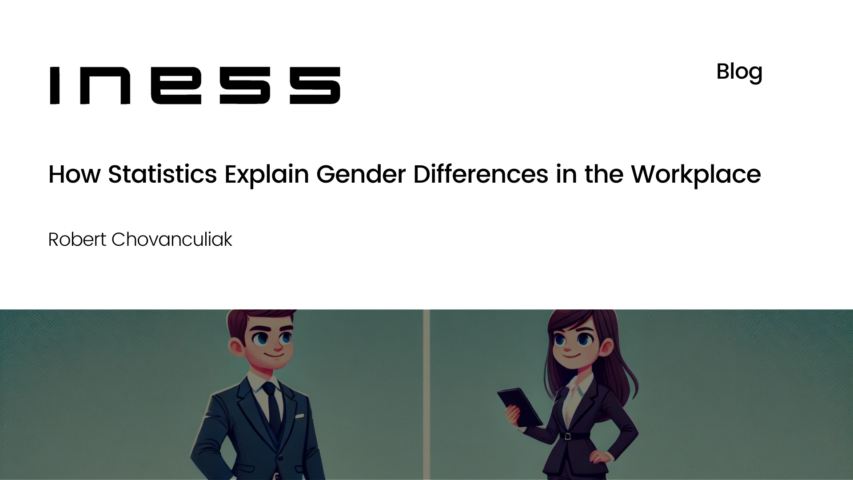How Statistics Explain Gender Differences in the Workplace

How Statistics Explain Gender Differences in the Workplace
Robert Chovanculiak // 13 July 2024
Several studies point to the fact that there is greater variability of traits, preferences, and characteristics among male individuals than among females. Moreover, this variability is greater in developed, wealthier, and more individualistic countries (including the Nordic countries mentioned above).
Greater variability thus implies, purely statistically, that while there may not be a difference in the average levels of various traits and characteristics across men and women, there may be differences in how they are distributed between the highest and lowest levels of the distribution.
Thus, for example, men may not be better on average at mathematical skills, but there may be more men among the world’s best mathematicians. Empirical research shows that the gender ratio among the top 1 per cent of mathematicians is 1:1 in favour of men. However, among the top 0.01 per cent of mathematicians, the ratio is 4:1 in favour of men. At the same time, the proportion of males among the worst mathematicians is similarly higher.
Consequently, if certain industries or companies select employees for high positions on the basis of exceptional ability, it is a statistical phenomenon that there will be a higher proportion of men on that spectrum of human ability. This appears to be true even for occupations that don’t require high-level skills as a prerequisite.
The result of this phenomenon may thus be that more Nobel Prize winners and CEOs can be found among men, but it is equally likely that more homeless or people without basic education would be men.
An interesting exception to this statistical effect is the skill of reading comprehension. In this skill, women are more highly represented among the best performers. However, men are again more highly represented among the worst performers.
Higher variability among men is seen not only in cognitive and psychological factors, but also in physiological factors such as body weight, height, running speed, and heart rate. It has also been observed to manifest at an early age. Three-year-old boys have higher IQ variability than girls, and in the first year of life, boys have higher brain variability too.
We find a similar phenomenon of greater male variability in most mammals and chimpanzees. All of these facts suggest that this is a biological manifestation and not the result of social and cultural pressures.
Unintended consequences It is typical for humans to look for the intent of an agent behind various phenomena. This bias is known as hyperactive agency detection.
Our ancestors saw intent behind natural phenomena and interpreted weather manifestations as the psychic state of deities. To humans today, such explanations may seem primitive. Similarly, our understanding of biological phenomena has advanced, where an acting ‘creator’ has been replaced by blind evolution.
However, people still attribute the existence of social phenomena to deliberate human design. This perception is extended to explaining the differences in salaries and positions between men and women.
However, this may be a limited way of understanding differences in society. Differences can arise and persist among human beings, but they need not be the result of bad intentions or discrimination.
For example, the difference in salaries between single, childless men and married, childless men in Slovakia is more than 30 per cent. Which category among these two earns higher may surprise you – it’s the married male employees.
However, the existence of this gap does not mean that stereotypical ideas about single men prevail in society, or that employers discriminate against them on the basis of such ideas. The explanation may well be that men’s marital status correlates with some of their preferences, qualities, or willingness to work steadily, on a long-term basis, and reliably. This correlation creates a statistical phenomenon in the form of wage differentials between married and single male employees.
This line of thinking could explain the differences in the salaries and job roles held by men and women. These differences may be the result of many factors that have nothing to do with malicious intent. The differences could be attributed to the result of men’s higher variability or different preferences.
A series of studies mapping the career and family preferences of men and women have revealed significant gender differences. Women have more core life goals in life than men, but a smaller proportion of these relate to career achievement. Also, women considered their career achievements less desirable compared to family life, although equally attainable as men.
This research does not say that there are no women who would be willing to sacrifice their families for a career. Nor does it say that most men are willing to do so. What the research does say is that in the relatively small group of people who are willing to sacrifice family life for a career, there are more men than women.
However, this does not mean that no employer in any workplace today discriminates against women on the basis of stereotypes. Such employers certainly exist, and women employees are impacted by their prejudiced decisions.
However, various empirical data and studies show that the situation today is certainly significantly better than in the past (at least in the Western world). Systemic discrimination is not necessarily the main explanation for the differences that exist in the salaries and roles of male and female employees.
The equal distribution of salaries and opportunities between men and women may not result in equal outputs or results. People are different, and they have different abilities, skills, preferences, and priorities.
Our goal should not be to become a society where both genders perform identically in all domains. Our goal should be to create a society where people can realise their full potential – men and women alike.
Finally, why should the main criterion for success be higher pay and not, for example, more meaningful work? Women seem to perform better than men on this measure.
This article is part two of a series on the gender pay gap in Europe. Click here to read part one.
This article was originally published by INESS in Slovak.
EPICENTER publications and contributions from our member think tanks are designed to promote the discussion of economic issues and the role of markets in solving economic and social problems. As with all EPICENTER publications, the views expressed here are those of the author and not EPICENTER or its member think tanks (which have no corporate view).



